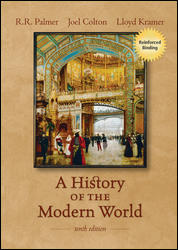 
History of the Modern World, 10th Edition (Palmer)Chapter 1:
The Rise of EuropeLearning ObjectivesChapter 1 teaches students about:
The origins of global modern civilization and the historical trends of modernity in which Europe played a central role. |
 |  |  |
Greek culture, which laid the foundations for later developments in political science and philosophy, and the spread of that culture around the Mediterranean world. |
 |  |  |
The Roman aptitudes for law, government, administration, and military organization, which allowed them to control a far-flung empire. |
 |  |  |
The emergence and spread of Christianity, and the new sense of human life promoted by the Christians. |
 |  |  |
Christian dualism, which allowed for the separation of spiritual and political power. |
 |  |  |
The decline of the Roman Empire, and its fragmentation into the Byzantine Empire and Latin Christendom. |
 |  |  |
The dynamism of the third part of the Mediterranean, the Arabic world. |
 |  |  |
The influence of Germanic culture and the invading barbarians' adoption of Roman culture. |
 |  |  |
The rise of new Christian religious institutions and the growing influence of the papacy. |
 |  |  |
The achievements of Charlemagne, which including a revival of learning and the reunification of the west for the first time since the Romans. |
 |  |  |
The appearance, by about 1000, of a recognizably European civilization. |
 |  |  |
The technological innovations in agriculture and the accompanying expansion of population that took place in the early Middle Ages. |
 |  |  |
The emergence of feudalism. |
 |  |  |
The growth of towns and commerce, and how towns represented a challenge to the feudal order. |
 |  |  |
The efforts of monarchs to consolidate their rule, and how parliaments checked monarchical power. |
 |  |  |
The causes for reforming the church in the high Middle Ages. |
 |  |  |
The founding of universities and the interests of medieval scholars in theology. |
 |  |  |
The crusades as one of the earliest movements of western expansion. |
 |  |
|





